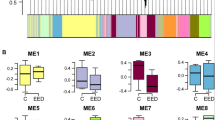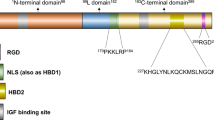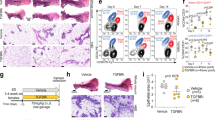Abstract
Expression microarray analysis identified over 930 genes regulated during puberty in the mouse mammary gland. Most prominent were genes whose expression increased in parallel with pubertal development and remained high thereafter. Members of the Wnt, transforming growth factor-β and oestrogen-signalling pathways were significantly overrepresented. Comparison to expression data from CITED1 knockout mice identified a subset of oestrogen-responsive genes displaying altered expression in the absence of CITED1. Included in this subset are stanniocalcin2 (Stc2) and amphiregulin (Areg). Chromatin immunoprecipitation revealed that ERα binds to oestrogen response elements in both the Stc2 and Areg genes in the mammary gland during puberty. Additionally, CITED1 and ERα localize to the same epithelial cells of the pubertal mammary gland, supporting a role for interaction of these two proteins during normal development. In a human breast cancer data set, expression of Stc2, Areg and CITED1 parallel that of ERα. Similar to ERα, CITED1 expression correlates with good outcome in breast cancer, implying that potential maintenance of the ERα–CITED1 co-regulated signalling pathway in breast tumours can indicate good prognosis.
This is a preview of subscription content, access via your institution
Access options
Subscribe to this journal
Receive 50 print issues and online access
$259.00 per year
only $5.18 per issue
Buy this article
- Purchase on Springer Link
- Instant access to full article PDF
Prices may be subject to local taxes which are calculated during checkout





Similar content being viewed by others
Accession codes
References
Allar MA, Wood TL . (2004). Expression of the insulin-like growth factor binding proteins during postnatal development of the murine mammary gland. Endocrinology 145: 2467–2477.
Bajic VB, Tan SL, Chong A, Tang S, Strom A, Gustafsson JA et al. (2003). Dragon ERE Finder version 2: a tool for accurate detection and analysis of estrogen response elements in vertebrate genomes. Nucleic Acids Res 31: 3605–3607.
Ball SM . (1998). The development of the terminal end bud in the prepubertal-pubertal mouse mammary gland. Anat Rec 250: 459–464.
Brisken C, Heineman A, Chavarria T, Elenbaas B, Tan J, Dey SK et al. (2000). Essential function of Wnt-4 in mammary gland development downstream of progesterone signaling. Genes Dev 14: 650–654.
Clarke RB, Howell A, Potten CS, Anderson E . (1997). Dissociation between steroid receptor expression and cell proliferation in the human breast. Cancer Res 57: 4987–4991.
Clarkson RW, Wayland MT, Lee J, Freeman T, Watson CJ . (2004). Gene expression profiling of mammary gland development reveals putative roles for death receptors and immune mediators in post-lactational regression. Breast Cancer Res 6: R92–R109.
Crowley MR, Head KL, Kwiatkowski DJ, Asch HL, Asch BB . (2000). The mouse mammary gland requires the actin-binding protein gelsolin for proper ductal morphogenesis. Dev Biol 225: 407–423.
D'Cruz CM, Moody SE, Master SR, Hartman JL, Keiper EA, Imielinski MB et al. (2002). Persistent parity-induced changes in growth factors, TGF-beta3, and differentiation in the rodent mammary gland. Mol Endocrinol 16: 2034–2051.
Daniel C, Silberstein G . (2000). Methods in Mammary Gland Biology and Breast Cancer Research. Kluwer Academic/Plenum Publishers: New York.
Draghici S, Khatri P, Bhavsar P, Shah A, Krawetz SA, Tainsky MA . (2003). Onto-Tools, the toolkit of the modern biologist: Onto-Express, Onto-Compare, Onto-Design and Onto-Translate. Nucleic Acids Res 31: 3775–3781.
Fournier MV, Martin KJ, Kenny PA, Xhaja K, Bosch I, Yaswen P et al. (2006). Gene expression signature in organized and growth-arrested mammary acini predicts good outcome in breast cancer. Cancer Res 66: 7095–7102.
Galang CK, Muller WJ, Foos G, Oshima RG, Hauser CA . (2004). Changes in the expression of many Ets family transcription factors and of potential target genes in normal mammary tissue and tumors. J Biol Chem 279: 11281–11292.
Gass S, Harris J, Ormandy C, Brisken C . (2003). Using gene expression arrays to elucidate transcriptional profiles underlying prolactin function. J Mammary Gland Biol Neoplasia 8: 269–285.
Herrington EE, Ram TG, Salomon DS, Johnson GR, Gullick WJ, Kenney N et al. (1997). Expression of epidermal growth factor-related proteins in the aged adult mouse mammary gland and their relationship to tumorigenesis. J Cell Physiol 170: 47–56.
Howlin J, McBryan J, Martin F . (2006a). Pubertal mammary gland development: insights from mouse models. J Mammary Gland Biol Neoplasia 11: 283–297.
Howlin J, McBryan J, Napoletano S, Lambe T, McArdle E, Shioda T et al. (2006b). CITED1 homozygous null mice display aberrant pubertal mammary ductal morphogenesis. Oncogene 25: 1532–1542.
Humphreys RC, Krajewska M, Krnacik S, Jaeger R, Weiher H, Krajewski S et al. (1996). Apoptosis in the terminal endbud of the murine mammary gland: a mechanism of ductal morphogenesis. Development 122: 4013–4022.
Juncker-Jensen A, Lykkesfeldt AE, Worm J, Ralfkiaer U, Espelund U, Jepsen JS . (2006). Insulin-like growth factor binding protein 2 is a marker for antiestrogen resistant human breast cancer cell lines but is not a major growth regulator. Growth Horm IGF Res 16: 224–239.
Kenney NJ, Smith GH, Rosenberg K, Cutler ML, Dickson RB . (1996). Induction of ductal morphogenesis and lobular hyperplasia by amphiregulin in the mouse mammary gland. Cell Growth Differ 7: 1769–1781.
Klopocki E, Kristiansen G, Wild PJ, Klaman I, Castanos-Velez E, Singer G et al. (2004). Loss of SFRP1 is associated with breast cancer progression and poor prognosis in early stage tumors. Int J Oncol 25: 641–649.
Kouros-Mehr H, Werb Z . (2006). Candidate regulators of mammary branching morphogenesis identified by genome-wide transcript analysis. Dev Dyn 235: 3404–3412.
Li H, Ahmed NU, Fenner MH, Ueda M, Isselbacher KJ, Shioda T . (1998). Regulation of expression of MSG1 melanocyte-specific nuclear protein in human melanocytes and melanoma cells. Exp Cell Res 242: 478–486.
Lincoln II DW, Bove K . (2005). The transcription factor Ets-1 in breast cancer. Front Biosci 10: 506–511.
Maeda T, Desouky J, Friedl A . (2006). Syndecan-1 expression by stromal fibroblasts promotes breast carcinoma growth in vivo and stimulates tumor angiogenesis. Oncogene 25: 1408–1412.
Mailleux AA, Overholtzer M, Schmelzle T, Bouillet P, Strasser A, Brugge JS . (2007). BIM regulates apoptosis during mammary ductal morphogenesis, and its absence reveals alternative cell death mechanisms. Dev Cell 12: 221–234.
Master SR, Hartman JL, D'Cruz CM, Moody SE, Keiper EA, Ha SI et al. (2002). Functional microarray analysis of mammary organogenesis reveals a developmental role in adaptive thermogenesis. Mol Endocrinol 16: 1185–1203.
Michaelson JS, Cho S, Browning B, Zheng TS, Lincecum JM, Wang MZ et al. (2005). Tweak induces mammary epithelial branching morphogenesis. Oncogene 24: 2613–2624.
Morris JS, Stein T, Pringle MA, Davies CR, Weber-Hall S, Ferrier RK et al. (2006). Involvement of axonal guidance proteins and their signaling partners in the developing mouse mammary gland. J Cell Physiol 206: 16–24.
Murtagh J, McArdle E, Gilligan E, Thornton L, Furlong F, Martin F . (2004). Organization of mammary epithelial cells into 3D acinar structures requires glucocorticoid and JNK signaling. J Cell Biol 166: 133–143.
Phang TL, Neville MC, Rudolph M, Hunter L . (2003). Trajectory clustering: a non-parametric method for grouping gene expression time courses, with applications to mammary development. Pac Symp Biocomput 8: 351–362.
Plisov S, Tsang M, Shi G, Boyle S, Yoshino K, Dunwoodie SL et al. (2005). Cited1 is a bifunctional transcriptional cofactor that regulates early nephronic patterning. J Am Soc Nephrol 16: 1632–1644.
Rudolph MC, McManaman JL, Hunter L, Phang T, Neville MC . (2003). Functional development of the mammary gland: use of expression profiling and trajectory clustering to reveal changes in gene expression during pregnancy, lactation, and involution. J Mammary Gland Biol Neoplasia 8: 287–307.
Russo J, Moral R, Balogh GA, Mailo D, Russo IH . (2005). The protective role of pregnancy in breast cancer. Breast Cancer Res 7: 131–142.
Shi G, Boyle SC, Sparrow DB, Dunwoodie SL, Shioda T, de Caestecker MP . (2006). The transcriptional activity of CITED1 is regulated by phosphorylation in a cell cycle-dependent manner. J Biol Chem 281: 27426–27435.
Stein T, Morris JS, Davies CR, Weber-Hall SJ, Duffy MA, Heath VJ et al. (2004). Involution of the mouse mammary gland is associated with an immune cascade and an acute-phase response, involving LBP, CD14 and STAT3. Breast Cancer Res 6: R75–R91.
Tang S, Han H, Bajic VB . (2004). ERGDB: Estrogen Responsive Genes Database. Nucleic Acids Res 32: D533–D536.
Uehara N, Unami A, Kiyozuka Y, Shikata N, Oishi Y, Tsubura A . (2006). Parous mammary glands exhibit distinct alterations in gene expression and proliferation responsiveness to carcinogenic stimuli in Lewis rats. Oncol Rep 15: 903–911.
van de Vijver MJ, He YD, van't Veer LJ, Dai H, Hart AA, Voskuil DW et al. (2002). A gene-expression signature as a predictor of survival in breast cancer. N Engl J Med 347: 1999–2009.
Weber-Hall SJ, Phippard DJ, Niemeyer CC, Dale TC . (1994). Developmental and hormonal regulation of Wnt gene expression in the mouse mammary gland. Differentiation 57: 205–214.
Werling RW, Hwang H, Yaziji H, Gown AM . (2003). Immunohistochemical distinction of invasive from noninvasive breast lesions: a comparative study of p63 versus calponin and smooth muscle myosin heavy chain. Am J Surg Pathol 27: 82–90.
Williams JM, Daniel CW . (1983). Mammary ductal elongation: differentiation of myoepithelium and basal lamina during branching morphogenesis. Dev Biol 97: 274–290.
Yahata T, Shao W, Endoh H, Hur J, Coser KR, Sun H et al. (2001). Selective coactivation of estrogen-dependent transcription by CITED1 CBP/p300-binding protein. Genes Dev 15: 2598–2612.
Yook JI, Li XY, Ota I, Hu C, Kim HS, Kim NH et al. (2006). A Wnt-Axin2-GSK3beta cascade regulates Snail1 activity in breast cancer cells. Nat Cell Biol 8: 1398–1406.
Zeps N, Bentel JM, Papadimitriou JM, D'Antuono MF, Dawkins HJ . (1998). Estrogen receptor-negative epithelial cells in mouse mammary gland development and growth. Differentiation 62: 221–226.
Zhang N, Zhong R, Wang ZY, Deuel TF . (1997). Human breast cancer growth inhibited in vivo by a dominant negative pleiotrophin mutant. J Biol Chem 272: 16733–16736.
Acknowledgements
We thank Joseph Mooney of the Biomedical Facility, Alison Murphy and Catherine Moss of the Conway Institute Core Facility, UCD, for their technical assistance. This work was supported by grants from Science Foundation Ireland, IRCSET, Ireland, and the Health Research Board, Ireland.
Author information
Authors and Affiliations
Corresponding author
Additional information
Supplementary Information accompanies the paper on the Oncogene website (http://www.nature.com/onc).
Rights and permissions
About this article
Cite this article
McBryan, J., Howlin, J., Kenny, P. et al. ERα–CITED1 co-regulated genes expressed during pubertal mammary gland development: implications for breast cancer prognosis. Oncogene 26, 6406–6419 (2007). https://doi.org/10.1038/sj.onc.1210468
Received:
Revised:
Accepted:
Published:
Issue Date:
DOI: https://doi.org/10.1038/sj.onc.1210468
Keywords
This article is cited by
-
CITED1 as a marker of favourable outcome in anti-endocrine treated, estrogen-receptor positive, lymph-node negative breast cancer
BMC Research Notes (2023)
-
Stanniocalcin 2 (STC2): a universal tumour biomarker and a potential therapeutical target
Journal of Experimental & Clinical Cancer Research (2022)
-
Doxycycline promotes proteasome fitness in the central nervous system
Scientific Reports (2021)
-
An Integrative Single-cell Transcriptomic Atlas of the Post-natal Mouse Mammary Gland Allows Discovery of New Developmental Trajectories in the Luminal Compartment
Journal of Mammary Gland Biology and Neoplasia (2021)
-
Amphiregulin deletion strongly attenuates the development of estrogen receptor-positive tumors in p53 mutant mice
Breast Cancer Research and Treatment (2020)



